Basic Attitude
The Nippon Shinyaku Group recognizes that its business activities benefit from biodiversity, while at the same time impacting it.
By accurately understanding the relationship between our Group’s activities and biodiversity and actively implementing initiatives that lead to the reduction of environmental impact, we will contribute to the maintenance and conservation of biodiversity and will aim to realize a sustainable society through building a society in harmony with nature.
We agree with the principles of the Keidanren Declaration for Biodiversity and Guideline (Revised Edition) formulated by KEIDANREN (Japan Business Federation) and have expressed our endorsement of the Declaration.
Conservation at the Yamashina Botanical Research Institute
Nippon Shinyaku’s Yamashina Botanical Research Institute was first opened in 1934 as the Yamashina Pilot Farm. It has since cultivated and conserved over 3,000 plant species, including Seriphridium maritimum (Artemisia maritima, commonly known as “sea wormwood”), the active ingredient of Santonin, an ascaricide that has largely contributed to Nippon Shinyaku’s business development. The Research Institute has also cultivated and conserved herbal and useful plants collected from around the world and plants that are objects of global concern for their possible imminent extinction, such as Welwitschia mirabilis.
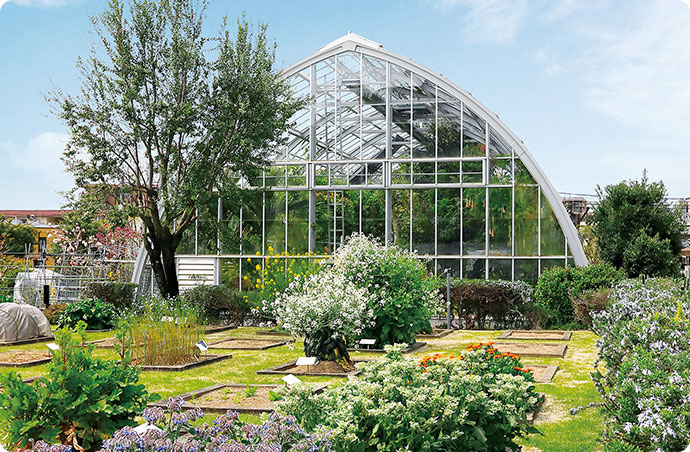
(Yamashina-ku, Kyoto City)
At the Yamashina Botanical Research Institute, we value research into cultivation from the perspective of biodiversity conservation. We participate in the local activities aimed at the preservation of rare plants native to Kyoto. For example, we are active in the protection and propagation of futaba aoi (Asarum caulescens Maxim.) and kikutani-giku (Chrysanthemum seticuspe).

(Yamashina-ku, Kyoto City)
Protection of endangered species
At the Yamashina Botanical Research Institute, we carry out activities designed to protect internationally recognized endangered plant species and those designated as endangered species by the Ministry of the Environment of Japan. We organize guided tours at the Institute on themes related to these plants.
The plants conserved and cultivated at the Yamashina Botanical Research Institute include over 160 species that are the botanical
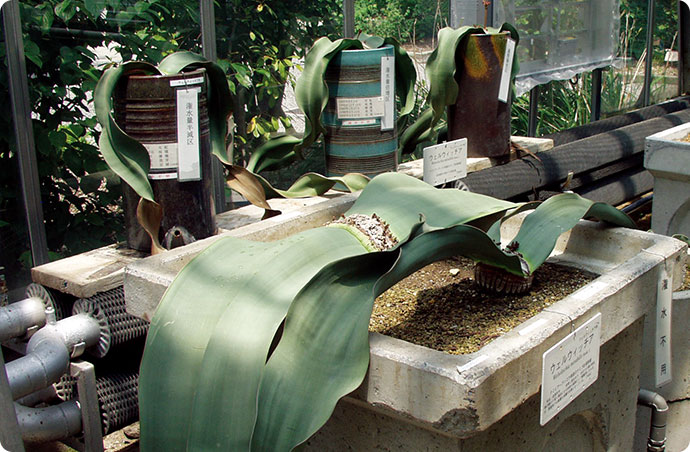
origins of herbal medicines recorded in the Japanese Pharmacopoeia, numerous internationally recognized endangered species, such as Welwitschia mirabilis, and those recognized as being in danger of extinction by the Ministry of the Environment of Japan.
We attach great importance to research into cultivation from the perspective of biodiversity conservation. We participate in the local activities for the preservation of rare plants native to Kyoto. For example, we are active in the protection and propagation of futaba aoi (Asarum caulescens Maxim.) and kikutani-giku (Chrysanthemum seticuspe).
Protection of endangered species
At the Yamashina Botanical Research Institute, we carry out activities designed to protect internationally recognized endangered plant species and those designated as endangered species by the Ministry of the Environment of Japan. We organize guided tours at the Institute on themes related to these plants.
The plants conserved and cultivated at the Yamashina Botanical Research Institute include over 160 species that are the botanical origins of herbal medicines recorded in the Japanese Pharmacopoeia, numerous internationally recognized endangered species, such as Welwitschia mirabilis, and those recognized as being in danger of extinction by the Ministry of the Environment of Japan.
We attach great importance to research into cultivation from the perspective of biodiversity conservation. We participate in the local activities for the preservation of rare plants native to Kyoto. For example, we are active in the protection and propagation of futaba aoi (Asarum caulescens Maxim.) and kikutani-giku (Chrysanthemum seticuspe).

Contribution to Biodiversity Contribution
Cultivation and dedication of futaba aoi (Asarum caulescens Maxim.)
Nippon Shinyaku participates in the Afuhi Project, a campaign launched by a general incorporated foundation established to preserve futaba aoi (Asarum caulescens), which is used in the Aoi Festival, one of the three major traditional festivals of Kyoto. Nippon Shinyaku takes part in the cultivation and ritual dedication of the plant for the festival. The number of futaba aoi growing in Kyoto has been
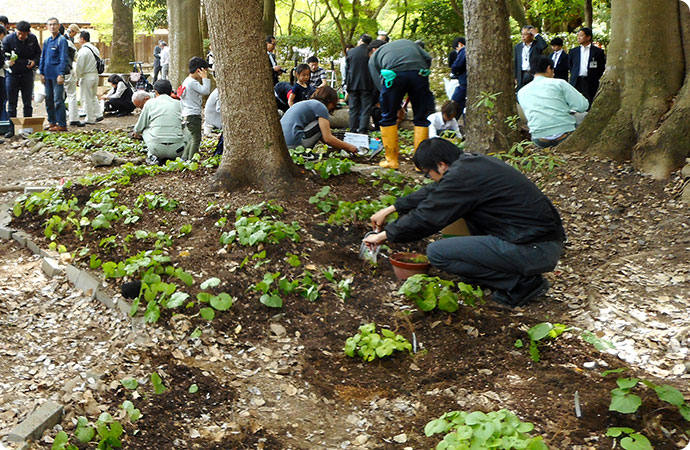
Afuhi Project general incorporated foundation
rapidly decreasing in recent years. In May 2024, we dedicated 200 pots of futaba aoi, which we had cultivated from seeds for three years.
* In 2009, the Afuhi Project was registered under the umbrella of the “Heritage for the Future” movement of the National Federation of UNESCO Associations in Japan.
Cultivation and dedication of futaba aoi (Asarum caulescens Maxim.)
Nippon Shinyaku participates in the Afuhi Project, a campaign launched by a general incorporated foundation established to preserve futaba aoi (Asarum caulescens), which is used in the Aoi Festival, one of the three major traditional festivals of Kyoto. Nippon Shinyaku takes part in the cultivation and ritual dedication of the plant for the festival. The number of futaba aoi growing in Kyoto has been rapidly decreasing in recent years. In May 2024, we dedicated 200 pots of futaba aoi, which we had cultivated from seeds for three years.
* In 2009, the Afuhi Project was registered under the umbrella of the “Heritage for the Future” movement of the National Federation of UNESCO Associations in Japan.

Afuhi Project general incorporated foundation
Cultivating and returning Chrysanthemum seticuspe to its natural habitat
Conservation activities by Nippon Shinyaku include cultivating and propagating Kyoto City’s endangered Chrysanthemum seticuspe to feature in Kyoto Imperial Palace and Kyoto City’s Kikutani Forest of Flowering Chrysanthemums (returning the plant to its natural habitat).
Protection and cultivation of fuji bakama (Eupatorium japonicum)
Fuji bakama (Eupatorium japonicum) is an age-old volunteer plant native to Kyoto (original wild species) designated by Kyoto Prefecture as being in danger of extinction. At the Yamashina Botanical Research Institute, we protect and cultivate this rare species. We also use fuji bakama as an example in our awareness-raising program for visitors on the theme of botanical diversity.
Survey of plants in the mountain and forests around Daigoji Temple, a World Cultural Heritage site
In June 2021, the G7 Nature Compact committed to the “30 by 30” initiative, whereby national governments designate more than 30% of land and sea areas as protected areas by 2030. As a result, attention is focusing on temple and shrine forests as areas other than protected areas that can contribute to biodiversity conservation. Focusing on the Daigoji Temple forest in the southern part of Kyoto City, Nippon Shinyaku has conducted sixteen surveys since April 2022 and identified 218 species of higher plants in 94 families.
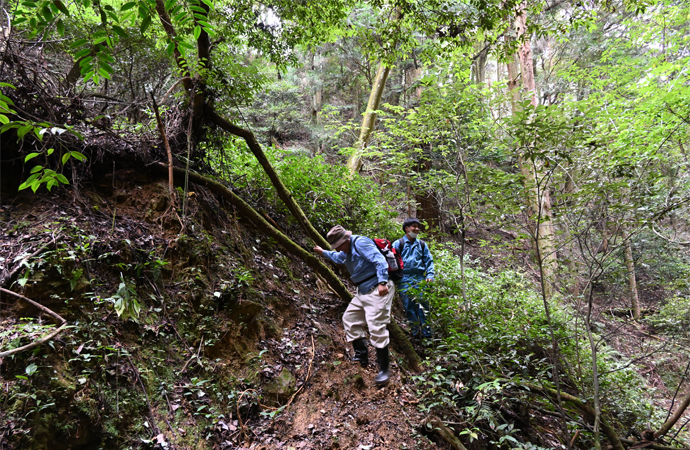
Ex situ conservation of the Japan-designated Natural Monument, ayumodoki
The ayumodoki (Parabotia curtus) is a freshwater fish endemic to Japan that has been drastically reduced due to environmental changes in its habitat and is now distributed only in the Kameoka Basin and Okayama Prefecture. Yamashina Botanical Research Institute collaborated with the Ministry of the Environment’s conservation and propagation project and succeeded in raising ayumodoki naturally in artificial ponds within its park grounds. We will continue to help conserve valuable wildlife as part of our biodiversity conservation activities.
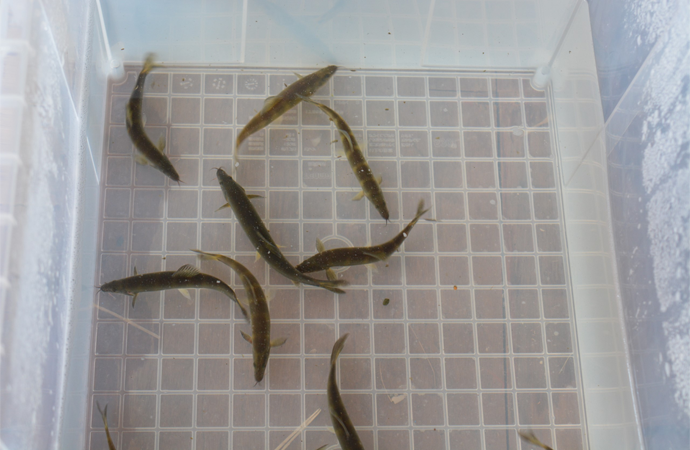
Conservation activities at Odawara Central Factory
In order to contribute to the conservation of endangered species and biodiversity, since 2024 the Odawara Central Factory has been participating in the conservation activities of the killifish in the Sakawa River system (commonly known as the Odawara killifish), an Odawara City endangered species. Odawara City has been implementing a citizen-participatory conservation activity called the “Medaka-no Otosan Okasan Seido (Killifish Foster Parent Program)” for more than 20 years. We have endorsed this initiative and are involved in the protection and breeding of the Odawara killifish as a foster parent.
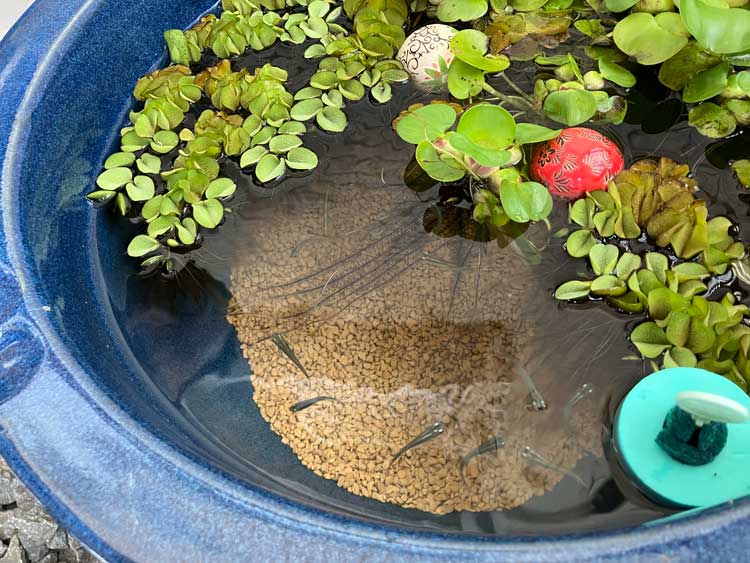
Volunteer cleanup activities
Our employees conduct cleanup activities in the Head Office area and at the Odawara Central Factory and the Discovery Research Laboratory in Tsukuba to contribute to creating a pleasant local environment. The Odawara Central Factory participates each year in “Clean Sakawa,” a cleanup project in which volunteer groups, local residents, companies, and others clean up the Sakawa River, one of Odawara’s representative rivers.
Appreciation by External Parties
Aboc CULTA Award
In 2017, Nippon Shinyaku was honored with the Aboc CULTA Award by the Japan Association of Botanical Gardens for its achievement of popularizing the scientific names of some plants.
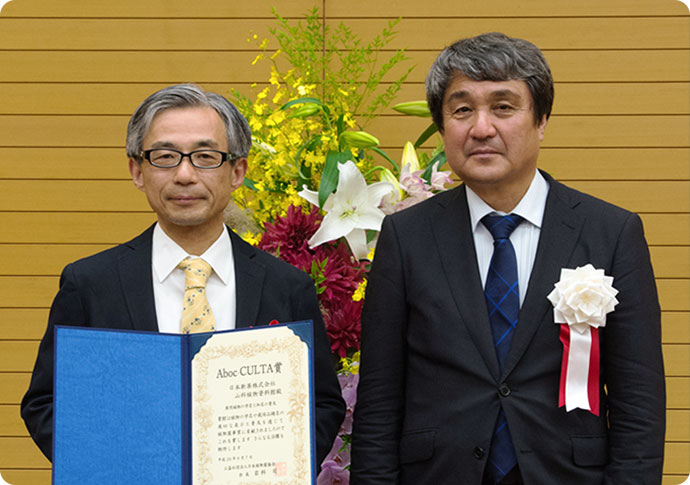
Kyoto City’s Kagayaki Award and Special Kagayaki Award
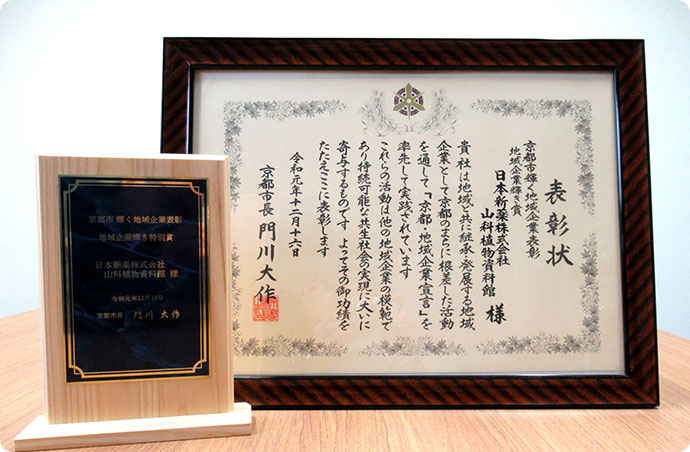
In 2019, the Yamashina Botanical Research Institute was nominated for commendation by Kyoto City for local companies that make outstanding achievements in specific categories. The company received the Kagayaki Award and Special Kagawaki Award.
The commendation system was instituted based on the Kyoto City Ordinance on the Promotion of Sustainable Development by Local Businesses established in April 2019. The awards are presented to local companies recognized as pursuing their business activities while nurturing deep ties with the local communities through contribution to general safety and security, activities leading to the preservation of cultural assets, natural environmental protection, and so forth.
With its collection of over 3,000 botanical species as its foundation, the Yamashina Botanical Research Institute regularly organizes tours, seminars, herb dyeing workshops for elementary school students, and other activities aimed at raising the general public’s awareness of the importance of biodiversity.
The Yamashina Botanical Research Institute is also active in the cultivation and propagation of rare plants that have been growing in Kyoto since the old days, such as futaba aoi (Asarum caulescens Maxim.) and kikutani-giku (Chrysanthemum seticuspe), as well as endangered species, thereby contributing to the preservation of cultural legacies and the natural environment in the region. The Research Institute also actively pursues community service programs, including, for example, the periodic cleanup of the Yamashina River to alleviate local water pollution.

Recognized as a Kyoto Biological & Cultural Regeneration Project
In 2019, the Yamashina Botanical Research Institute was officially recognized and registered as the executor of a Kyoto Biological & Cultural Regeneration Project. It is a voluntary project that an organization launches to preserve and regenerate any rare animals or plants that have a distinctive place in traditional Kyoto culture. Kyoto City screens applicant organizations and their projects based on the city’s original Biodiversity Conservation Plan for official recognition and registration.
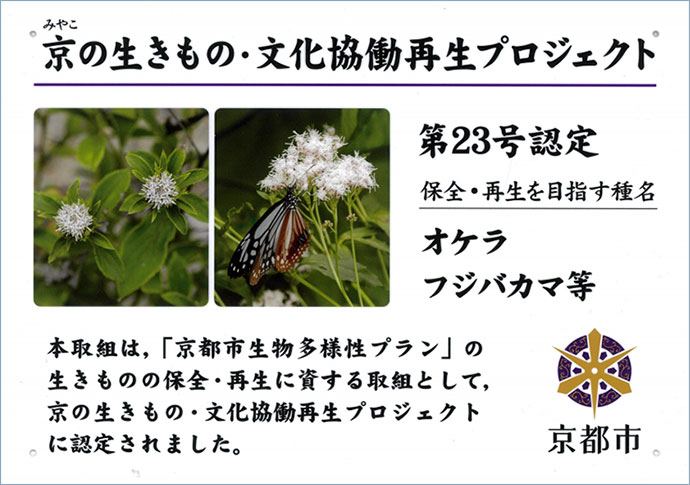
In the Project, the Yamashina Botanical Research Institute promotes the preservation of plants, such as okera (Atractylodes ovata), fuji bakama (Eupatorium japonicum), and kikyo (Platycodon grandiflorus), which are inseparable from Kyoto’s traditional cultural landscape. In addition, the Research Institute actively promotes the preservation of endangered plants registered in Kyoto Prefecture’s Red Book and organizes related educational and awareness-raising activities.
In 2019, the Yamashina Botanical Research Institute was officially recognized and registered as the executor of a Kyoto Biological & Cultural Regeneration Project. It is a voluntary project that an organization launches to preserve and regenerate any rare animals or plants that have a distinctive place in traditional Kyoto culture. Kyoto City screens applicant organizations and their projects based on the city’s original Biodiversity Conservation Plan for official recognition and registration.
In the Project, the Yamashina Botanical Research Institute promotes the preservation of plants, such as okera (Atractylodes ovata), fuji bakama (Eupatorium japonicum), and kikyo (Platycodon grandiflorus), which are inseparable from Kyoto’s traditional cultural landscape. In addition, the Research Institute actively promotes the preservation of endangered plants registered in Kyoto Prefecture’s Red Book and organizes related educational and awareness-raising activities.

Kyoto Environmental Award (Honorable Mention)
Kyoto City established the Kyoto Environmental Award with the aim of raising interest in the environment and promoting various practical activities that contribute to environmental conservation, such as preventing global warming, creating a recycling-oriented society, and maintaining biodiversity. During the COVID-19 pandemic, the Yamashina Botanical Research Institute held virtual tours in place of face-to-face tours and received an Honorable Mention in the Kyoto Environmental Award for this initiative.







